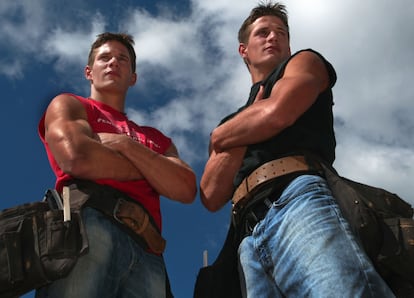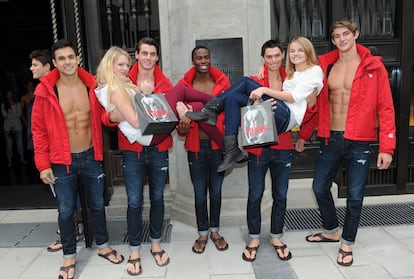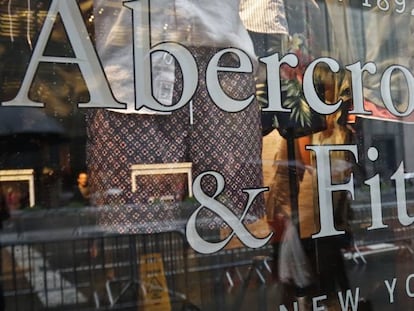How Abercrombie & Fitch, the company of hunks and Aryan models that young Americans hated the most, has managed to resurrect itself
The clothing chain that symbolized the most exclusionary fashion paradigm in the early 2000s is now rising from the ashes after a complete facelift and catalog overhaul; its stock market value has skyrocketed.

Not even the most cutting-edge Artificial Intelligence companies have been able to keep up. Throughout 2023, clothing brand Abercrombie & Fitch’s shares gave the best stock market performance in the S&P 1500 index, with growth of up to 285% in just twelve months. The figure represents the firm’s best annual performance since its initial public offering in 1996. That showing confirms the miraculous reinvention of a phenomenon that succeeded in retail in this century’s first decade using a strategy based on a white, privileged, hypersexualized and discriminatory fashion look. “We go after the cool kids. We go after the attractive all-American kid with a great attitude and a lot of friends. A lot of people don’t belong [in our clothes], and they can’t belong. Are we exclusionary? Absolutely,” former CEO Mike Jeffries said in 2006. He made sure to endow the brand’s stores with clerks who looked like models and had the torsos and iron abs of a Greek god.
However, that exclusionary American fantasy — shared by its sister brand, Hollister — soon crumbled in the face of the many voices calling for greater inclusion and gender and racial equality in the fashion world and a series of scandals that caused the store terrible reputational damage: from discriminatory hiring practices to racist messages on its T-shirts and the demand for more diverse sizing in its garments. In 2015, the multinational’s accounts plummeted by 80%, the company closed over 450 stores worldwide and its future seemed so amortized that a couple of years ago Netflix released a documentary (White Hot: The Rise & Fall of Abercrombie & Fitch) about its resounding failure in the form of an epitaph and moral. Maybe it’s time to start preparing the sequel.

“When I joined the company it was a difficult time for Abercrombie and for Hollister, with health declining dramatically. But there was an opportunity to rebuild them and bring them back. I just felt they were two iconic brands that deserved to live again,” Fran Horowitz, the current CEO and leader of the resurrection, explained last November. Defying an unfavorable context characterized by the decline of shopping malls (Abercrombie stores’ main refuge in its previous iteration), the hegemony of fast fashion and digital commerce and a seriously damaged public image (Jeffries, its former head, has been accused of sexual exploitation), Abercrombie & Fitch has managed to grow its sales by 14% in 2023 compared to the previous fiscal year, exceeding initial expectations by up to four points.
The strategy began with an aggressive rebranding to leave behind the exclusionary standards that led it to be named the company most hated by young people in the United States. One need only go to its website to find models of different sizes, ages and ethnicities and corporate initiatives dedicated to social justice for underrepresented groups and sustainability. “Here, we celebrate diversity in front of and behind the camera and weave it throughout the very fabric of our brand and all we stand for,” they say under the slogan “That’s Abercrombie today.” That “today” — which is the only word highlighted in bold in the slogan — is loaded with meaning. Gone are the days when the company proudly boasted of not manufacturing garments beyond size L; today’s A&F bases half of its denim sales on the Curve Love line, with styles designed to flatter bodies of any size. Historically a brand for men, women’s fashion now accounts for most of Abercrombie’s business. For its part, Hollister directly targets the teenage consumer to accentuate the differences from its sister brands that used to overlap.
The company has transitioned from casual fashion to slightly more elevated closet essentials. Tight T-shirts, sweatshirts with big logos and low-slung pants have given way to blazers, sportswear, party dresses and office suits, focusing on the target demographic of just-out-of-college 20-somethings who are getting their first taste of professional life. Horowitz approached his team about the need to become a brand that would dress this niche market at any time during what he calls “the long weekend,” that is, from Thursday through Sunday. “There is nothing better than being a young millennial, they are in the best moment of their lives. By the time Monday rolls around they’re already thinking about what they’re doing next weekend. We had to make sure we could dress them for those 96 hours... As simple as it sounds, and it’s not, that was the turning point for us,” the CEO confirmed to WWD. Abercrombie no longer wants to dress the quarterback and high school prom king, but rather the president of the science club.
The franchise’s stores have not escaped this recent facelift, which has jettisoned the dizzying smell of sandalwood and bergamot air freshener, the windows closed to the outside and the homoerotic photographs on the walls in favor of smaller, more efficient, minimalist and cozy stores. “Abercrombie isn’t trying to be too trendy — they’re offering classic silhouettes in classic colors, and it’s working very well for them,” says fashion analyst Kristen Classi-Zummo. In recent months, the hashtag #Abercrombieisback has gone viral on TikTok, with hundreds of influencers sharing their excitement at the iconic brand’s return.
The brand’s first store opened in New York in 1892, founded by Scottish-born surveyor David Abercrombie; it sought to dress elite men for outdoor activities such as hunting and sailing. A few years later, a wealthy lawyer named Ezra Fitch, a regular customer of the brand, joined as a partner. The two had different visions for the future, and in 1907 he bought out Abercrombie and expanded to the general public, adding a women’s clothing line and opening large stores across the country. Its customers included former President Teddy Roosevelt, aviator Amelia Earhart and writers such as John Steinbeck and Ernest Hemingway; legend has it that the latter bought the shotgun with which he committed suicide at Abercrombie & Fitch. After being on the verge of disappearing at different times during the 1960s, 1970s and 1980s, Mike Jeffries was hired in 1992; under his stewardship, he revitalized the company until it fell from grace. Now, the textile industry’s most discreet resurrection is about to rise again, this time as the favorite brand of the same generation that repudiated it less than a decade ago.
Sign up for our weekly newsletter to get more English-language news coverage from EL PAÍS USA Edition
Tu suscripción se está usando en otro dispositivo
¿Quieres añadir otro usuario a tu suscripción?
Si continúas leyendo en este dispositivo, no se podrá leer en el otro.
FlechaTu suscripción se está usando en otro dispositivo y solo puedes acceder a EL PAÍS desde un dispositivo a la vez.
Si quieres compartir tu cuenta, cambia tu suscripción a la modalidad Premium, así podrás añadir otro usuario. Cada uno accederá con su propia cuenta de email, lo que os permitirá personalizar vuestra experiencia en EL PAÍS.
¿Tienes una suscripción de empresa? Accede aquí para contratar más cuentas.
En el caso de no saber quién está usando tu cuenta, te recomendamos cambiar tu contraseña aquí.
Si decides continuar compartiendo tu cuenta, este mensaje se mostrará en tu dispositivo y en el de la otra persona que está usando tu cuenta de forma indefinida, afectando a tu experiencia de lectura. Puedes consultar aquí los términos y condiciones de la suscripción digital.
More information
Últimas noticias
Most viewed
- Christian Louboutin: ‘Young people don’t want to be like their parents. And if their parents wear sneakers, they’re going to look for something else’
- ‘El Limones’ and the growing union disguise of Mexican organized crime
- Cartels in Mexico take a leap forward with narco-drones: ‘It is criminal groups that are leading the innovation race’
- The low-cost creative revolution: How technology is making art accessible to everyone
- ‘We are dying’: Cuba sinks into a health crisis amid medicine shortages and misdiagnosis











































